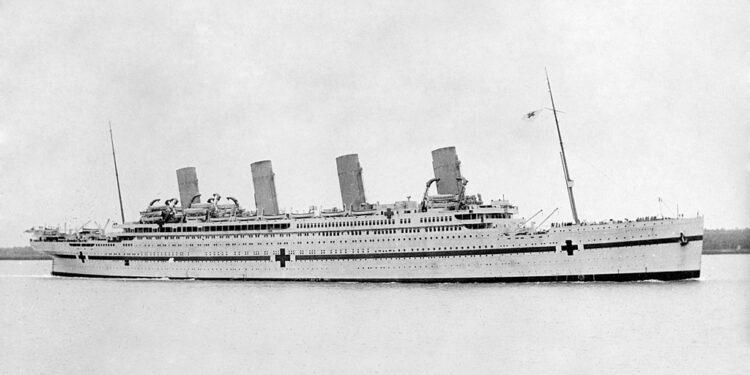Contents
Questo articolo è disponibile anche in:
The early 1900s are certainly linked to the construction of ocean liners: luxurious and gigantic passenger ships created specifically to cross the Atlantic, transporting civilians from Europe to America and vice versa, in an attempt to beat the times more and more, reaching their destination earlier of all the others.
Among the numerous naval companies, British White Star Line was certainly among those which, until today, have remained firm in the collective memory. This is certainly due to the “trio” of enormous transatlantic liners, the largest for that time, which White Star Line commissioned at the beginning of the XX century: the Olympic, the Britannic and, certainly the most famous of the three, the Titanic.
Of course, collective imagination, thanks also to media and cinema, has always been attentive towards the latter, whose maiden voyage was unfortunately also the last, sinking after hitting an iceberg a few days after departing Southampton. The Titanic lies on the ocean floor, at a depth of almost 13.000 ft, unreachable except by extremely sophisticated means, capable of withstanding the strong pressure. In recent times, the ship has unfortunately made a comeback to fame, with the recent tragic news of the submersible Titan.
But the Atlantic Ocean is not the only sea in whose waters rests a wreck of such gigantic dimensions: the Mediterranean Sea, in fact, holds the remains of the sister ship HMHS Britannic which, unlike her unfortunate sister, never had the time to fulfill the task for which it was built.
HMHS Britannic: the “lesser-known” twin
It was 1907 when White Star Line ordered the construction of the first ship of the trio: Harland & Wolff shipbuilding company began to work on the Olympic. The order for the Britannic, however, came much later: in 1911, remaining in the shipyard until 1914, two years after the tragic sinking of the Titanic.
The short life of the ship was immediately changed by the first of the terrible events that would characterize the twentieth century: the outbreak of the First World War. For this reason, there was never time for a maiden voyage as a transatlantic liner: the ship was requisitioned, repainted in white with large green stripes and red crosses, assuming the wording HMHS, or His Majesty Hospital Ship.
The first mission of the hospital ship took place at the end of December 1915: in the following months, five successful missions followed one another, which often led the ocean liner to sail between the waters of the Mediterranean Sea. During the summer of 1916, it was decided that the ship could be returned to civil service, but this did not happen because the Britannic was requisitioned again by the government, holding her status as a hospital ship .
An unnoticed sinking
Like her more famous sister, Britannic also had an extremely short life: less than a year after her first voyage, she met her end off the coast of Kea, an island in Greece. The ship, in fact, hit a German mine, which ripped it open: although she had been reinforced in order to resist with more flooded compartments, following the Titanic disaster, her damages were too extensive to save her.

Many were the efforts of captain Charles Bartlett to get the ship as close to land as possible, to strand her. But, despite this, the ship leaned more and more: the evacuation was ordered and, less than an hour after the accident, HMHS Britannic was swallowed up by the waters of the Mediterranean, leaning on a side. In any case, it was a one-of-a-kind sinking: the ship, in fact, is longer than the depth where it rests today (400 ft against the circa 900 ft of the ship), therefore one part touched the bottom while another was still on the surface .
The Britannic was the largest ship lost in World War II and the second of White Star Line’s three sister ships to sink. Only one out of three had more luck: the Olympic, also used during the war and the only one to have even managed to sink a submarine, returned to its role as a civilian vessel until the mid-1930s, when it reached the its natural “retirement”, being dismantled.
However, unlike the Titanic, the loss of the Britannic was less considered. First of all, the victims were much less: only 30, against the more than 1,500 of the famous transatlantic liner. This was due not only to the increased precautionary measures thanks to the Titanic accident, but also to the shallower and decidedly warmer waters (about 20° against the -2° of the Atlantic Ocean).
Even the interest in the wreck was rather scarce: the discovery of the Titanic in 1985 started , expecially in the contemporary age, the tourism machine. Instead, even if found ten years earlier, in better conservation conditions and with a simpler accessibility, the wreck of the Britannic has always remained in the background.
The wreck, however, is an important tourist attraction for the island of Kea, from whose coast it is very few miles away. Furthermore, another wreck was recently found near the island, that of the SS Burdigala, sunk a few days before the Britannic, possibly torpedoed or, similarly to the transatlantic, due to the impact with a mine. This wreck, therefore, can be grouped with the numerous underwater treasures of the Mediterranean Sea which, between submarine volcanoes and numerous wrecks that are waiting to be discovered, has so much to offer to its explorers.
The Mediterranean Sea, therefore, has its “titanic” wreck. The Britannic will not have had its Jack and Rose nor the attention of the world media, limiting itself to just one film; but, however brief, the hospital ship’s operations certainly changed the fate of the hundreds of people who boarded it during her few missions. The wreck remains now, as well as its more famous sister, an important testimony of a time now gone, whose charm never ceases to enchant more than a century after its sinking.
Stay up to date by following us on Telegram!


















